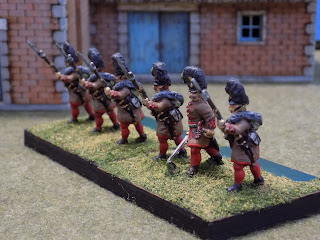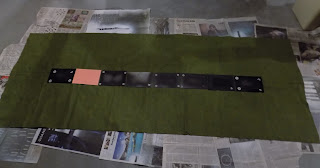...and my last project of 2016 returns to the scene of the crime and coincides with the new year--I once again used Eagle Figures Napoleonic Austrian Grenadiers to convert. This time, into Honved grenadiers of the Hungarian Revolution, 1848-49. [as always, clix pix for BIG PIX]
Here is what I was aiming for...
...Honved Grenadier, above left, image from The Honved Army, 1848-1849 by Gyozo Somogyi. I used the image of reenactors in Budepest (right) to inform the detail on the bearskin (the yellow top).
Once again, I brought out the Green Stuff and modified the Eagle Figures Austrian Greandier with Rolled Greatcoat ...
..by shaving off the oak sprig and cockade, and the legging buttons. Then I extended the length of the coat and modified the bearskin--covering up the plate and filling it out to form the more bushy mid-century version. I then added the largish cockade. (Before and after above.)
As I've mentioned in a previous post, brown uniforms do present something of a challenge. as far as providing some sort of differentiation. Here is the panoply of paint I wound up using on this uniform that would, on the surface, appear to be two tone: brown and red...
...there are something like 7 different shades of brown, two reds, and four grays. Once again, these contribute to an overall effect, even if they aren't obvious (that's my story and I'm sticking with it!). Those of a certain age will notice that I am still using "Old Skool" enamels: a mix of Humbrol, Model Master, and the small bottle Testor's (you can't beat their red and metallics). I started painting with these before the earth cooled, and they're in my DNA.
Here is the result:
Red on brown doesn't stand out very well, so I had to resort to black-lining (not my strong suit) in order to bring out some of the detail.
I also had to free-hand in the cuff loops on the soldiers and the more extensive braiding on on the officer. With only 6 figures, I could manage (if this were a larger unit, maybe not).
And so, I conclude 2016 the same way that I started, with grenadiers for my Chocolate Box Wars Project:
The latest: Honved Grenadiers, left, and the first: Austrian Grenadiers, right.
Thanks for your interest in this blog and my projects thus far. I'm looking forward to continuing into 2017 and arriving at my first full year blogging. Happy New Year!
Excelsior!























































